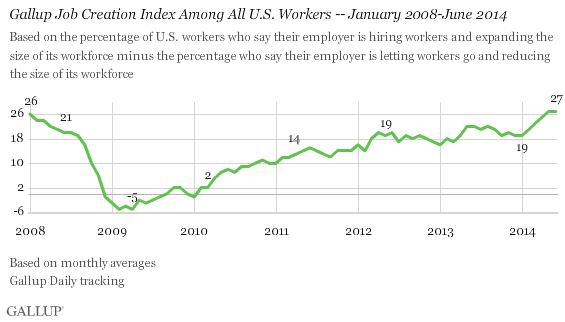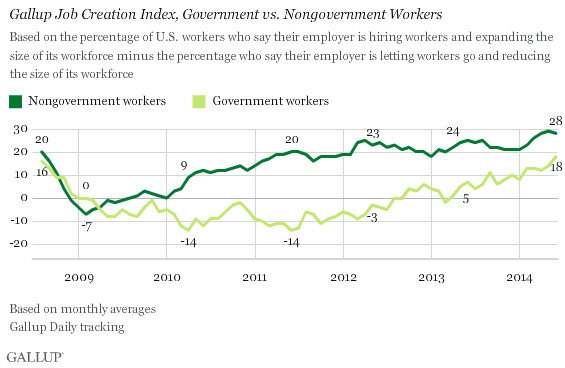WASHINGTON, D.C. -- Gallup's U.S. Job Creation Index registered at +27 in June, tying May's index as the highest score in more than six years of tracking this measure.

Gallup's Job Creation Index is a measure of net hiring activity in the U.S., with the monthly average based on a nationally representative sample of more than 16,000 full- and part-time workers in June. As was the case in May, June's +27 index score is based on 40% of employees saying their employer is hiring workers and expanding the size of its workforce and 13% saying their employer is letting workers go and reducing the size of its workforce. Another 41% report no change in staffing.
The index sank over the course of the 2008 recession and was in negative territory for much of 2009, reaching a record low of -5 in February and April of 2009. The index improved in 2010 and 2011, reaching +20 by April 2012, and it hovered around that mark throughout 2012 and 2013. This year, after starting off in January at +19, the index has shown gains of exactly two points each month before leveling off at +27 in June.
Government Workers' Hiring Perceptions Reach New High
The Job Creation Index score among government workers increased four points from May, resulting in a net hiring score of +18 for June. This score is the highest since the +16 in August 2008, when Gallup first began to measure government employment. The index score increased in June among federal, state, and local government workers, though state and local government workers continue to report a more positive hiring situation than do federal workers.
The Job Creation Index score among nongovernment workers registered at +28 for June, similar to +29 in May.

Since there are many more nongovernment workers than government workers, the one-point dip in the index among nongovernment workers is more than enough to offset the four-point gain in the index among government workers, leading to no change in the overall index in June.
Bottom Line
After five months of U.S. workers reporting increased hiring at their workplaces, June's index score maintained the level from May. June's score could represent a brief halt in the consistent increases in the index so far in 2014, but it could also signal that job creation perceptions are leveling off after a five-month period of progress for the job market.
Gallup's U.S. Job Creation Index suggests that the U.S. Department of Labor jobs report for June may be poised to bring good news, but the Job Creation Index for July will be a measure to watch as it could indicate what may come in the second half of 2014.
Survey Methods
Results for this Gallup poll are based on telephone interviews conducted June 1-30, 2014, on the Gallup Daily tracking survey, with a random sample of 16,743 adults employed full or part time, aged 18 and older, living in all 50 U.S. states and the District of Columbia.
For results based on the total sample of workers, the margin of sampling error is ±1 percentage points at the 95% confidence level.
Interviews are conducted with respondents on landline telephones and cellular phones, with interviews conducted in Spanish for respondents who are primarily Spanish-speaking. Each sample of national adults includes a minimum quota of 50% cellphone respondents and 50% landline respondents, with additional minimum quotas by time zone within region. Landline and cellular telephone numbers are selected using random-digit-dial methods. Landline respondents are chosen at random within each household on the basis of which member had the most recent birthday.
Samples are weighted to correct for unequal selection probability, nonresponse, and double coverage of landline and cell users in the two sampling frames. They are also weighted to match the national demographics of gender, age, race, Hispanic ethnicity, education, region, population density, and phone status (cellphone only/landline only/both, and cellphone mostly). Demographic weighting targets are based on the most recent Current Population Survey figures for the aged 18 and older U.S. population. Phone status targets are based on the most recent National Health Interview Survey. Population density targets are based on the most recent U.S. census. All reported margins of sampling error include the computed design effects for weighting.
In addition to sampling error, question wording and practical difficulties in conducting surveys can introduce error or bias into the findings of public opinion polls.
For more details on Gallup's polling methodology, visit www.gallup.com.
